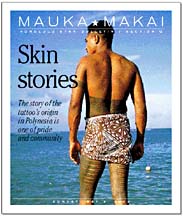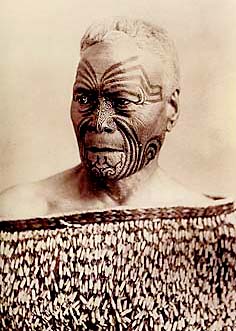
[ MAUKA MAKAI ]
PACIFIC ISLANDERS IN COMMUNICATION
The work of tattoo artist Keone Nunes adorns the body of Maui farmer Kyle Nakanelua.
Skin as canvas
A PBS documentary takes a
respectful look at Polynesian cultures
reclaiming their tattooing heritage
Deciding to get a tattoo doesn't exactly require intellectual debate. But the decision to get a design to be permanently, and painfully, etched somewhere on your person should not be taken lightly.The decision is usually based on a deep desire to literally make one's mark on the world. To separate oneself from the banal and mundane. To tap into one's mana, expressed on one's most personal of canvases.
Back in the late '70s, Emiko Omori, of San Francisco, got her first tattoo, one that covers her back, depicting a Buddhist story of a pearl diver rescuing a magic jewel from a dragon. The complicated design took several years off and on to complete.
The tattoo was based on the painting and ukiyo-e woodblock printing style of Utagawa Kuniyoshi. In fact, his style was so popular during the Edo period that he was reportedly asked often by men to tattoo his intricate art on their bodies.
Omori has been a documentary filmmaker for more than three decades, distinguishing herself as the Bay area's first Asian-American news camerawoman and, later, as an award winner for the poignant 1999 documentary "Rabbit in the Moon."
But it's obvious the art of the tattoo has been important to Omori, personally and professionally. She had earlier created "Tattoo City," a documentary about D.E. Hardy's Japanese-styled full-body tattooing. Then two years ago, her longtime interest in the art form was piqued again when she found herself researching and working on a documentary about its origins in Polynesia.
PACIFIC ISLANDERS IN COMMUNICATION
This photograph, titled "Unknown Woman of Rotorua District, North Island," circa 1910, is a rare portrait of a "moko," or face tattoo, applied by grouped darning needles by tattoo artist Tame Poata. The subject is an Arawa woman of high rank.
The resulting documentary, "Skin Stories," gets its overdue national airing tonight on PBS Hawaii. It's a reverential and sensitive look at how the various cultures have reclaimed the cultural heritage of tattooing that dates back 2,000 years. Her documentary traces its migration across the Pacific, where the practice has had a renaissance, taking it beyond the realm of bikers and military personnel to the streets. Body adornment, whether tattoo or piercing, is all the current rage.
While there's a tagged-on segment with three American subjects near the end of "Skin Stories," the documentary is driven by interviews with tattoo artists and grateful recipients from Samoa, Aotearoa (New Zealand), Tonga and Hawaii. It's here that there's an emphasis on keeping one's culture alive and, maybe just as important, a communal aspect to tattooing. During the painful and long process, friends and family gather to give needed support. It's all part of perpetuating what's been called "the regal cloth of Polynesia."
"NOWADAYS, the Polynesian people use the tattoo to reclaim their culture and identity," Omori said. "Whereas anybody can get one for whatever personal reasons, here it takes a deeper meaning. It's something that you don't take lightly, especially if one's getting a bigger piece done.
"Also, to keep the practice truly traditional, one has to ask permission from the chiefs in order to get a tattoo, like in Samoa and the Maori people. In Hawaii the tradition was practically gone."
PACIFIC ISLANDERS IN COMMUNICATION
This original watercolor by Joseph Jenner Merrett, from the collection of Mark and Carolyn Blackburn, shows good examples of "moko" (face tattoos) and buttock tattoos.
Omori's documentary contains revealing interviews with two of her subjects, kumu hula Frank Kawaikapuokalani Hewitt and Maui farmer Kyle Nakanelua. Hewitt said he was considered "pupule" and a bit of an enigma back in 1972 when he started to get traditional tattoos all over his body. Nakanelua, seen working his taro patches in Keanae, said that local tattoo artist Keone Nunes so thoroughly questioned his intentions of wanting one that only after years of family research and learning the Hawaiian language was Nakanelua ready to receive his tattoo.
But the most touching segment of "Skin Stories" is the one shared by Manu Neho and Tuhipo Kereopa. They tell of the Maori women of Aotearoa who perpetuated their people's tradition well into the 20th century. Neho's story is particularly poignant, as she says she went through a "natural regression" to being more Maori after leaving the Mormon church. A series of photos are shown of her receiving her "moko" (facial tattoo) as she and about 70 of her loved ones experienced what she said was the completion of her rebirth as a Maori woman.
"It was a very touching and profound moment, and she speaks for everyone in the movie, one way or another," Omori said. "I wanted her and the others to tell their own stories, with narration kept to a minimum -- to let the people say what they were thinking, without scholars and historians chiming in."
It's the story of Samoan tattoo artist Leo Zuleta, who was drawn to the primal aspect of the process of creating exquisite-looking "pe'a" (large midtorso-to-knees tattoos on men), drawing on the tradition of using soot from burnt candlenuts, and later having the men gently submerging themselves into the healing ocean waters.
PACIFIC ISLANDERS IN COMMUNICATION
Manu Neho, left, and Tuhipo Kereopa, Maori women from a village in Aotearoa, New Zealand, think their moko (facial tattoos) fit their stylish chapeaus.
And it's the story of Aisea Toetu'u, a Tongan now living on Oahu who used tattooing as a way to pull him out of gang life. Using a mixture of Polynesian styles, he has created a new hybrid tribal body art of his own.
"THE ENTIRE story is laid out to roughly follow the migratory path of how tattooing spread throughout Polynesia," said Lisa Altieri, co-producer with Omori and Karin Williams, and editor of "Skin Stories."
The Hawaii-born and raised Altieri has concentrated on documentary work here, especially in the last three years, and has done intern and consultant work with Pacific Islanders in Communication, who worked with KPBS in San Diego to help complete "Skin Stories."
While Altieri distinguishes herself through the editing of the documentary, she has nothing but praise for her co-workers. "Emiko has a wonderful artistic approach to documentary making," she said. "She's such a creative director, in the way she sets up the shots. I also have to give credit to the woman who shot it, Diana Wilmar, our fabulous camera operator from Seattle. During the 14 weeks Emiko and I crafted the story in editing, it was such a joy to work with her footage."
PACIFIC ISLANDERS IN COMMUNICATION
"Tuterei Karewa, a chief of the Ngati Maru of the Thames District, North Island" shows a dark moko highlighted by the photographer. The picture, circa 1890s, is from the collection of Mark and Carolyn Blackburn.
In the process of telling the story, Omori was inspired to add another tattoo to her body, this time an etched wristband by Maori artist Gordon Hatfield.
"Getting tattooed is like becoming part of another subculture," she said. "I find it wonderful because once our subjects found out about my full-back tattoo, it became like a calling card into their own culture. I wasn't just another middle-aged documentarian. It gave me entry."
"Skin Stories"
>> Screens 1 to 3 p.m. today as part of Family Sunday at Bishop Museum. A related panel discussion, "The Meaning of Tattoo in Modern Polynesia," with producers Lisa Altieri and Emiko Omori, and featured artists Lesa Moli and Keone Nunes, will be given. Immediately after the 1 p.m. panel, there will be a live demonstration of traditional Samoan and Hawaiian tattooing. Admission is $3 per person or $10 per family of four. Tickets will be available at the museum's box office.>> Airs at 9:30 tonight on PBS Hawaii, with an encore presentation at 1 p.m. on May 18.
Click for online
calendars and events.






